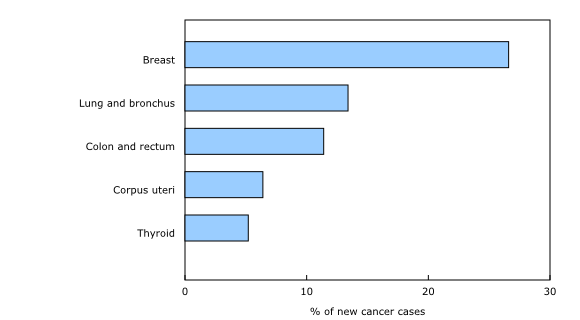Cancer incidence in Canada, 2012
Archived Content
Information identified as archived is provided for reference, research or recordkeeping purposes. It is not subject to the Government of Canada Web Standards and has not been altered or updated since it was archived. Please "contact us" to request a format other than those available.
Released: 2015-10-23
There were more than 175,000 new cases of cancer diagnosed in Canada in 2012, which translates to an incidence rate of over 500 cases per 100,000 people. Although this is a 10.6% increase compared with a decade earlier, the age-standardized incidence rate, which controls for aging in the population, has decreased by 4.6% to 384.4 cancers per 100,000 people.
Data from the Canadian Cancer Registry show that there were 88,885 men and 86,420 women who received a cancer diagnosis in 2012. Older Canadians are more likely to be diagnosed with cancer. Among all new cases diagnosed in 2012, 87.6% were among people aged 50 or older, 11.2% were among those aged 25 to 49, while 1.2% were among those under 25 years old.
The five most commonly diagnosed cancers for men and women of all ages continued to be lung (13.9% of new cases), breast for women (13.2%), colorectal (12.4%), prostate (11.9%) and bladder (4.3%). Colorectal cancer surpassed prostate for third place among the top five from a year earlier. These five cancers combined accounted for over half (55.7%) of all new cancers.
Cancer among men
In 2012, 88,885 men were diagnosed with cancer, an incidence rate of 518.5 cases per 100,000 men.
During that year, the most frequently diagnosed cancer among men was prostate, which accounted for 23.6% of all new cancer cases diagnosed. This was followed by lung (14.4%), colorectal (13.3%), bladder (6.3%) and non-Hodgkin lymphoma (4.4%). These five cancers accounted for 61.9% of all newly diagnosed cancers in men in 2012, and their ranking has remained steady for a decade.
The most frequently diagnosed cancers differ by age group. For men, under the age of 25, testicular cancer (14.9%) was the most often diagnosed, with colorectal cancer for those 25 to 49 years (11.9%), and prostate cancer for men aged 50 and older (25.4%).
Cancer among women
There were 86,420 women newly diagnosed with cancer in 2012, representing 495.1 cases per 100,000 women in the Canadian population.
For women, the most frequently diagnosed cancer was breast cancer, which accounted for 26.6% of all new cancer cases in 2012. This was followed by lung (13.4%), colorectal (11.4%), uterine (6.4%) and thyroid (5.2%) cancer. These five cancers accounted for 63.0% of all newly diagnosed cancers in women in 2012. Thyroid cancer was the fifth most commonly diagnosed cancer, a change from 2002 when it was the seventh.
For women under the age of 25, the top cancer was thyroid (17.6%). Breast was the number one cancer for both women aged 25 to 49 (34.7%) and women aged 50 and older (25.5%).
Cancer incidence over time
When controlling for the aging of the population, the cancer incidence rate decreased from 403.1 per 100,000 people in 2002 to 384.4 per 100,000 people in 2012. During this period, the age-standardized incidence rate for men fell from 466.6 to 416.9 per 100,000 people, while for women the rate increased from 358.9 to 362.3 per 100,000 people.
The top five cancers remained the same for men between 2002 and 2012 when controlling for the aging population. For women, the first three cancers (breast, lung and colorectal) stayed the same. However, thyroid moved from sixth to fourth place and uterine from fourth to fifth place. Non-Hodgkin lymphoma fell from the top five in 2012.
Note to readers
Data for 2011 are also available.
The Canadian Cancer Registry (CCR) is a dynamic database of all Canadian residents, alive or dead, who have been diagnosed with cancer since 1992. The CCR is a patient-based system that records the type and number (incidence) of primary cancers diagnosed for each person until death.
The CCR can be updated with new records or changes to previous records; therefore, the incidence counts may change from one release to the next. In particular, data for the most recent years often represent an undercount of total cases due to a delay in the reporting of new cancer cases to the CCR. These missing cases are added to their appropriate diagnosis year with the reporting of a new reference year.
Cancer incidence refers to the number of new cases of cancer in a population over a given period, usually one year. This rate may be expressed as the number of cancer cases per 100,000 people.
Cancer incidence data for Quebec are not available for the 2011 and 2012 diagnosis years within the CCR. For CANSIM tables 103-0550 and 103-0553, the 2010 Quebec data have been copied forward into 2011 and 2012.
Age standardization
Since cancer is more likely to occur in older people, the age structure of a population will have a strong influence on the cancer incidence rates observed. To allow more valid comparisons over time, age-standardized rates are used to control for differences in population age structure. The age-standardized rate is the rate that would occur if the population of interest had the same age structure as the standard population. The standard population used here is the final postcensal estimates of the July 1, 1991, Canadian population. Age-standardized rates and incidence rates are not comparable.
Contact information
For more information, or to enquire about the concepts, methods or data quality of this release, contact us (toll-free 1-800-263-1136; 514-283-8300; infostats@statcan.gc.ca) or Media Relations (613-951-4636; statcan.mediahotline-ligneinfomedias.statcan@canada.ca).
- Date modified:



